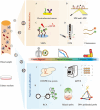The new advance of exosome-based liquid biopsy for cancer diagnosis
- PMID: 39380060
- PMCID: PMC11463159
- DOI: 10.1186/s12951-024-02863-0
The new advance of exosome-based liquid biopsy for cancer diagnosis
Abstract
Liquid biopsy is a minimally invasive method that uses biofluid samples instead of tissue samples for cancer diagnosis. Exosomes are small extracellular vesicles secreted by donor cells and act as mediators of intercellular communication in human health and disease. Due to their important roles, exosomes have been considered as promising biomarkers for liquid biopsy. However, traditional methods for exosome isolation and cargo detection methods are time-consuming and inefficient, limiting their practical application. In the past decades, many new strategies, such as microfluidic chips, nanowire arrays and electrochemical biosensors, have been proposed to achieve rapid, accurate and high-throughput detection and analysis of exosomes. In this review, we discussed about the new advance in exosome-based liquid biopsy technology, including isolation, enrichment, cargo detection and analysis approaches. The comparison of currently available methods is also included. Finally, we summarized the advantages and limitations of the present strategies and further gave a perspective to their future translational use.
Keywords: Biomarker; Cancer; Diagnosis; Exosomes; Liquid biopsy.
© 2024. The Author(s).
Conflict of interest statement
The authors declare no competing interests.
Figures




Similar articles
-
Recent Advances in Exosomal Protein Detection Via Liquid Biopsy Biosensors for Cancer Screening, Diagnosis, and Prognosis.AAPS J. 2018 Mar 8;20(2):41. doi: 10.1208/s12248-018-0201-1. AAPS J. 2018. PMID: 29520676 Free PMC article. Review.
-
Recent advances in nanotechnology-enabled biosensors for detection of exosomes as new cancer liquid biopsy.Exp Biol Med (Maywood). 2022 Dec;247(23):2152-2172. doi: 10.1177/15353702221110813. Epub 2022 Aug 6. Exp Biol Med (Maywood). 2022. PMID: 35938477 Free PMC article. Review.
-
Exosomes as a new frontier of cancer liquid biopsy.Mol Cancer. 2022 Feb 18;21(1):56. doi: 10.1186/s12943-022-01509-9. Mol Cancer. 2022. PMID: 35180868 Free PMC article. Review.
-
Microfluidic-Based Exosome Analysis for Liquid Biopsy.Small Methods. 2021 Mar;5(3):e2001131. doi: 10.1002/smtd.202001131. Epub 2021 Jan 18. Small Methods. 2021. PMID: 34927834 Review.
-
Optical, electrochemical and electrical (nano)biosensors for detection of exosomes: A comprehensive overview.Biosens Bioelectron. 2020 Aug 1;161:112222. doi: 10.1016/j.bios.2020.112222. Epub 2020 Apr 21. Biosens Bioelectron. 2020. PMID: 32365010 Review.
Cited by
-
Exosomes: innovative biomarkers leading the charge in non-invasive cancer diagnostics.Theranostics. 2025 Apr 13;15(11):5277-5311. doi: 10.7150/thno.113650. eCollection 2025. Theranostics. 2025. PMID: 40303340 Free PMC article. Review.
-
Diagnostic and Prognostic Significance of Exosomes and Their Components in Patients With Cancers.Cancer Med. 2025 Jan;14(1):e70569. doi: 10.1002/cam4.70569. Cancer Med. 2025. PMID: 39757782 Free PMC article. Review.
-
Isolation of Plasma Extracellular Vesicles for High-Depth Analysis of Proteomic Biomarkers in Metastatic Castration-Resistant Prostate Cancer Patients.Cancers (Basel). 2024 Dec 21;16(24):4261. doi: 10.3390/cancers16244261. Cancers (Basel). 2024. PMID: 39766159 Free PMC article.
-
Neutrophil- and Endothelial Cell-Derived Extracellular Microvesicles Are Promising Putative Biomarkers for Breast Cancer Diagnosis.Biomedicines. 2025 Feb 27;13(3):587. doi: 10.3390/biomedicines13030587. Biomedicines. 2025. PMID: 40149564 Free PMC article.
-
Exosomes in Precision Oncology and Beyond: From Bench to Bedside in Diagnostics and Therapeutics.Cancers (Basel). 2025 Mar 10;17(6):940. doi: 10.3390/cancers17060940. Cancers (Basel). 2025. PMID: 40149276 Free PMC article. Review.
References
-
- Siegel RL, Miller KD, Wagle NS, Jemal A. Cancer statistics, 2023. Cancer J Clin. 2023;73:17–48. - PubMed
-
- Shafritz DA, Shouval D, Sherman HI, Hadziyannis SJ, Kew MC. Integration of Hepatitis B Virus DNA into the genome of liver cells in Chronic Liver Disease and Hepatocellular Carcinoma. N Engl J Med. 1981;305:1067–73. - PubMed
-
- Heitzer E, Haque IS, Roberts CES, Speicher MR. Current and future perspectives of liquid biopsies in genomics-driven oncology. Nat Rev Genet. 2018;20:71–88. - PubMed
Publication types
MeSH terms
Substances
Grants and funding
- 2023M741431/China Postdoctoral Science Foundation
- SH2023048/Zhenjiang City Science and Technology Innovation Fund
- 81972310/National Natural Science Foundation of China
- 81972310/National Natural Science Foundation of China
- BK20200043/Distinguished Young Scholar Project of Jiangsu Province
- BK20200043/Distinguished Young Scholar Project of Jiangsu Province
- 18KJA320001/Major Natural Science Research Project for Universities in Jiangsu Province
- 18KJA320001/Major Natural Science Research Project for Universities in Jiangsu Province
- 2019GSZDSYS01,2019GSZDSYS02/Key Laboratory of Molecular Diagnostics and Precision Medicine for Surgical Oncology in Gansu Province
- 2019GSZDSYS01,2019GSZDSYS02/Key Laboratory of Molecular Diagnostics and Precision Medicine for Surgical Oncology in Gansu Province
- PADA/Priority Academic Program Development of Jiangsu Higher Education Institutions
- PADA/Priority Academic Program Development of Jiangsu Higher Education Institutions
LinkOut - more resources
Full Text Sources
Medical
Miscellaneous

